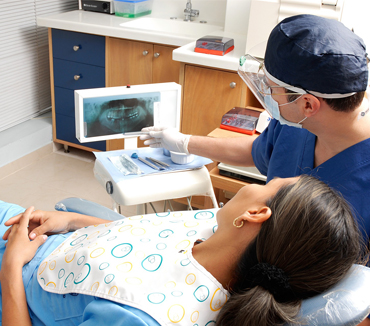Periodontitis diagnosis and treatment
What is periodontal disease?
With the busy pace of life, sometimes it can be easy to let oral hygiene slip. But taking care of your oral health is key to keeping your entire body healthy. Like any disease, oral diseases such as gum disease can be harmful to the body. If your gums are not taken care of, an advanced stage of gum disease can occur known as periodontal disease. Periodontal disease is characterized by infection and inflammation of the gums and surrounding oral tissues. This can lead to destruction of the gum tissue, bone loss, mobile teeth, and tooth loss.
What are the stages of periodontitis?

Periodontitis is a chronic inflammatory disease that can become progressively worse if not treated. The early stage of gum disease is known as gingivitis, which is often characterized by signs of bleeding and inflamed gums. This is typically caused by poor oral hygiene resulting in dental plaque, which is a buildup of bacteria and food particles that stick to the surfaces of teeth. Plaque can cause your teeth to become discolored and can lead to permanent white/brown spots and tooth decay. If oral hygiene is not properly managed, this can advance into more destructive stages of gum disease:
1. Early periodontal disease
One of the main signs of early periodontal disease is gum recession. When this happens, your gums appear to pull away from your teeth exposing more of the tooth and root. This occurs as a result of the bacteria destroying the gum tissue and supporting bone.
2. Moderate periodontal disease
As periodontal disease begins to progress, your teeth may become sensitive and loose. Further inflammation, bone loss and gum recession will gradually occur. In addition, the bacterial infection may stimulate an inflammation in other parts of the body.
3. Advanced periodontal disease
At this stage, the bacterial infection has aggressively attacked the gums, bone, and other supporting oral tissues. Advanced periodontitis can have debilitating effects, including severe bone loss, extreme tooth pain when chewing, and foul-smelling breath and taste in the mouth. Consequently, tooth loss is very common at this stage.
Symptoms of periodontitis
Symptoms of periodontitis may vary for each individual. Some individuals are asymptomatic early on, while others may experience oral pain and sensitivity. In addition, gum recession, loose teeth, trouble chewing, bad breath, altered taste, and inflamed or bleeding gums are other common signs and symptoms of periodontitis. It is important to not ignore these signs and symptoms. Let your dental professional know if you are experiencing any of these issues so that diagnosis and treatment can begin immediately before problems progress.
Causes of Periodontitis
Poor oral hygiene is one of the most common causes of periodontitis. Lacking good oral hygiene allows bacteria to thrive and wreak havoc in your mouth as a result of plaque buildup. Thankfully, taking good care of your teeth and gums can help you prevent periodontitis. Other factors that may place you at a higher risk of developing periodontitis include tobacco use, stress, certain medications that reduce saliva production, poor diet and inadequate nutrition, hormonal changes, genetics, weakened immunity, and other systemic inflammatory diseases.
How to prevent Periodontitis?
Periodontitis can be prevented with good lifestyle choices. Focus on perfecting your oral hygiene routine by brushing your teeth at least twice a day for two minutes each time, and don’t skip out on flossing at least once a day. Schedule regular dental appointments for cleanings and examinations to help ensure that your teeth are healthy and sparkling. Although some risk factors of periodontitis are out of our control, do your best to avoid habits that you can control that place you at higher risk for developing periodontitis. If you are a tobacco user, make strides towards quitting. Update your diet to limit consumption of sugary and acidic products that give oral bacteria a good environment to cause damage. Instead, aim for creating a diet full of vitamins and nutrients to help improve both your oral and overall health.
Diagnosis of periodontitis
Confirming a diagnosis of periodontitis first typically starts with a thorough dental examination performed by your dental professionals. They will review your medical and dental history, take X-rays of your teeth to check for tooth decay and examine your bone levels, and probe the gums surrounding each tooth. The dental probe will help your dentist measure the gum pocket depth and evaluate gum recession and root exposure. On average, a measurement of 1-3 mm is considered normal pocket depth. Pockets ranging from 4-5 mm indicate early periodontitis. Pocket depths greater than 5 mm suggest a more advanced stage of periodontitis. After evaluation, your dentist may classify what stage of periodontitis is present and may recommend more frequent dental visits depending on your specific needs.
What are the complications of periodontitis?
Periodontitis can lead to permanent negative changes in your mouth if untreated. Common complications of periodontitis include:
- Tooth mobility
- Tooth loss
- Bone loss
- Painful abscesses
- Changes in your bite due to migration of your teeth
- Gum recession and root exposure
- Toothaches
Plus, since the mouth is a window into the rest of your body, periodontitis can increase your risk of developing other health conditions like heart disease, stroke, diabetes, and respiratory illnesses. Periodontitis may even result in complications for pregnant women, such as increasing the likelihood of premature birth, low birth weight, and preeclampsia.
How is periapical periodontitis treated?
Surgical and Non-surgical
Depending on the cause and severity of periapical periodontitis, your dentist may suggest either non-surgical or surgical treatment:
Non-surgical:
- If your dentist diagnoses you with periapical periodontitis, this refers to inflammation surrounding the apex of the tooth’s root.
- Your dentist may recommend endodontic treatment, also known as root canal therapy. A root canal involves removing the bacterial infection from within your tooth. Once removed, the canal is sealed with a filling material.
- To help reduce inflammation and improve gum health, your dentist may recommend scaling and root planing. This involves a deep cleaning of your tooth enamel and roots to remove bacterial plaque and tartar buildup.
Surgical:
- If the surfaces of your tooth and root are hard to access for bacterial removal, your dentist may recommend gum flap surgery to help clean underneath the gums. Following the procedure, sutures are placed to help reattach the gum tissue.
- Bone grafting procedures may be recommended if excessive bone loss has occurred to help stimulate bone regeneration.
- If you had a root canal procedure performed in the past but infection still persists, a referral to an endodontic specialist may be recommended to perform an apicoectomy. This procedure involves removal of the tooth’s root apex, which is then replaced with a filling material.
- If you are experiencing severe gum recession, gum graft surgery may be suggested. This involves grafting new tissue to cover exposed tooth roots which are more susceptible to tooth decay and sensitivity than your tooth’s enamel.
- If after evaluation your tooth is deemed unrestorable, your dentist may recommend tooth extraction.
Our doctors and dental specialists provide a wide range of dental services at our 40+ multi-specialty dental offices across Massachusetts and New Hampshire. Our dental team is compassionate, and our main goal is to provide you a comfortable, caring dental experience. Book an appointment at your local Gentle Dental today.



